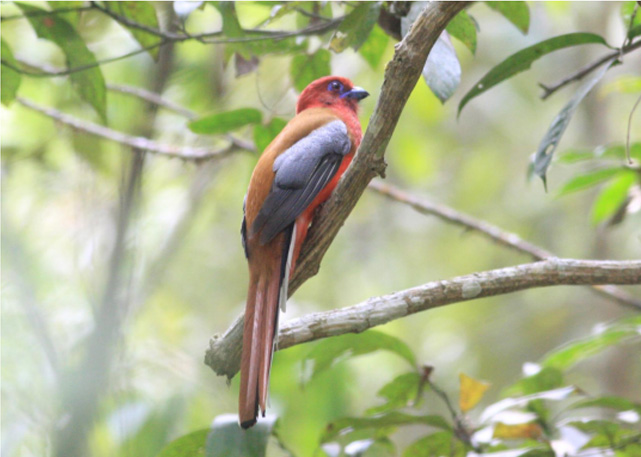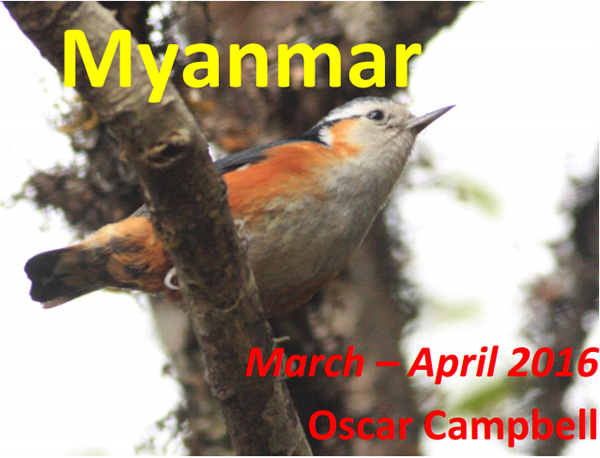
This report outlines a birding trip to Myanmar, concentrating on the core areas of Bagan, Mount Victoria, Kalaw and Inle Lake that now comprise the standard birding circuit of this fascinating and bird-rich country. The trip began and ended with a night in central Yangon, with a morning flight in and evening flight out 15 ½ days later on Bangkok Airways.
Unusually for us, we elected to use a local agent to arrange these. For this we selected Myanmar Travel Expert(http://www.myanmartravelexpert.com/) and, for a pretty reasonable cost, they booked the hotels to our specification, internal flights (Yangon – Bagan – Heho – Yangon) and provided a car and driver for the duration, plus the necessary local guide for the Chin Hills / Mt Victoria leg. Somewhat to our surprise, it would have been perfectly possible to do most of the ground arrangements (apart from Mt Victoria) on our own, with lots of good hotels and fairly easy transport options evident on the ground. However, despite that, Myanmar Travel Expert proved a very good choice. Initial correspondence via email was smooth and fast and their arrangements when we arrived flawless. Transport and driver (Than Aye, well worth asking for and with the infinite patience and ability to function at the unearthly hours necessary when dealing with birders) proved excellent, our guide for Mt Victoria (Ko Ye Min) was very enthusiastic and a great photographer and the company owner Moe Aung met us twice, including on arrival at the airport and clearly really cared about his clients, staff and country. In all, MTE come highly recommended. We transferred half the cost to a bank in Singapore on booking and paid the rest in US Dollars on arrival. We were careful to bring lots of the latter with us but, with hindsight this was not necessary, as ATMs were frequent in the main centres and the only one we tried accepted Visa / MasterCard without a hitch.
We opted out of full board and foraged for ourselves each evening; this proved a good choice with plenty of cheap and tasty eats and cold beer everywhere we stayed (save for Mt Victoria, where we ate at our lodging; the food here was as good and reasonably priced as anywhere). All hotels were booked by MTE and all proved very good, without being over the top. All are listed in the recent Lonely Planet guidebook: East Hotel (Yangon), Arathkwa Hotel (Bagan), Pine Wood Villa (Mt Victoria) Dream Villa Hotel (Kalaw) and Golden Empress Hotel (Inle)
Again, booked by MTE. All were conveniently timed, giving us an early arrival in both Bagan and Kalaw the days we flew in there and all were on-time and pain-free. Myanmar airports are both quiet and basic so it was necessary to get to check-in a mere 30-45 mins or so before any flight.
April is the end of the birding (and general tourist) season in Myanmar. Most of the lowlands are pretty hot, with Yangon especially steamy and humid at up to 40o C. The Bagan area was slightly but perceptibly cooler and less humid (up to c 35o C); Mt Victoria (elevations 1800-3100m) was, in contrast, cool and fresh throughout although we had heavy rain for 1-2 hrs on two of the three afternoons we spent there. Kalaw (1300m) was very pleasant most of the day save for a few hours around midday, and Lake Inle (900m) was rather warmer still, but not oppressively so. Being at the end of the dry season, much of Bagan and Inle were dusty and hazy with rather poor sunsets and limited views of the surrounding hills.
was pretty easy, by Asian forest standards, most of the time. Activity was pleasantly high throughoutthe day at most sites. Early March / late April doubtless was too late for a few interesting Himalayan drifters on Mt Victoria but, more than compensating for that, many breeding birds were on territory and very active. Hence we enjoyed plenty of good bush warbler action, all the Phyllos singing like crazy and many flycatchers, with increasing numbers of cuckoos as the trip progressed. In addition, some important (eg Grey-sided Thrush, Marten’s Warbler and Baikal Bush-Warbler) or just otherwise notable (eg Siberian Rubythroat, Yellow-streaked Warbler, Pied Harrier) wintering species were still pretty easy to find and I was also pleased with a good range of returning passage migrants too (eg Ferruginous and Brown-breasted Flycatchers at Kalaw, masses of wagtails and Oriental Pratincoles at Inle).
I used a few trip reports for Myanmar available at
http://www.cloudbirders.com/
with
http://www.cloudbirders.com/tripreport/repository/GRUNDSTEN_Myanmar_12_2012.pdf
and
http://www.cloudbirders.com/tripreport/repository/COLLAERTS_Myanmar_2012-2013.pdf
especially useful.
In addition,
http://www.estbirding.ee/artiklid/trip-report-myanmar-71-2712012,
which I have just found,
looks pretty ok too; otherwise detailed independent trip reports were somewhat
hard to come by. My
battered old copy of Robson (2000) was ok for most things, although is now a bit
out of date with regard to
taxonomy; I neglected to bring Rasmussen & Anderton (2012) but with hindsight
that would have been quite
useful, especially in the Chin Hills. Of course, I mined Xeno-canto for sounds
and made good use of my own
recording gear, which proved useful for luring bush-warblers and checking the ID
of various Phyllos and
Seicercus warblers. Some of the recordings I made, totaling 45 tracks of 39
species, are available for download
by clicking this link. A scope was particularly useful for getting good views of
forest birds at Mt Victoria and
Kalaw and also for working the field and rice paddies at the north end of Inle.
This trip comprised 15 days. This included three full days in the Bagan area, to allow for some tourist things (ballooning and a visit to Mount Popa) and two nights (almost two full days) at Inle. These were both a bit longer than most groups have but, not having a guide, we wanted more time to soak things up and find things for ourselves. Three full days were spent on Mt Victoria; this was sufficient to give a pretty thorough look at the place but not enough to mop up the parrotbills. One full day getting to Mt Victoria was also well spent, with excellent roadside birding en-route. Finally, we had a late afternoon, full day and early morning at Kalaw which, unless you are totally hung-up on the necessity of Burmese Yuhina, was about right. Yangon is a pretty interesting city and we had nearly full day there at the start and then 30 hours at the end, which included a visit to Hlwagu Park (see below)
( 1 ) Bagan This is a spectacular place, to say the least, with decent birding everywhere amongst thousands of temples. Several of the dry zone endemics (White-throated Babbler and Burmese Bushlark) are hard to miss and can be found anywhere, in our case in the first half hour. However, Jerdon’s Minivet and Hooded Treepie needed some specific gen and a large slice of luck, respectively. As exact details of the best spots were not too explicit in any of the trip reports I had, the necessary information, at least as of March 2016, is as follows:
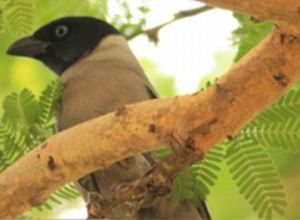
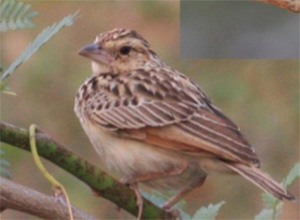
A. Sittana Paya: (sometimes written, and generally pronounced, Sistyana). This imposing temple 1-2 km south of New Bagan was the single best birding spot locally. The area right below and temple outer wall, including the nearby bean fields and the short track to the obvious rubbish dump, were the places we concentrated on. Jerdon’s Minivets were located instantly on two (out of two) visits (first a flock, secondly a lone male) feeding in the sparse field right by the wall and no more than 50m from the parking area. As at many of the bigger temples early and late on, Vinousbreasted Mynas were common and obvious and the thorny scrub around the dump held high densities of species such as Burmese Bushlark, White-throated Babblers, Asian Green Bee-eater, ‘ Burmese’ Collared Dove etc. Hooded Treepie is apparently about here, but not for us. Adjacent bean fields were well worth working, with Rain Quail and Barred Buttonquail regularly flushed, although getting any more than a back end flight view took some effort. Quality migrants in here included (presumed) Pin-tailed Snipe, Thick-billed Warbler, Blue-tailed Bee-eater and, in some drier scrub at the back, a nice male Siberian Rubythroat.
B. Sulimani Phato: Although busy and thronged with tourists, this impressive temple held up to three Lagger Falcons, easily seen on two visits in the middle of the day. They were mainly perching on the temple below the main stupa but also seen soaring high and drifting about up to a km away. Within the temple walls, Spotted Owlet and White-throated Babbler were easy. On the second day, having long given up at Sittana, we walked around the nearby small dam (Manu Kan) and, in an isolated tree near the lake, fluked a Hooded Treepie, flying out of the big, waterside yellow fever-type trees and into canopy. Here it was hard to find, gorging on large bugs and very silent; if we had not seen it break cover we’d never have found it. In the area of Sulimani, as at Sittana, we found Yellow-streaked Warbler fairly obvious and not far away had a White-eyed Buzzard. The only Brown Prinia of the trip was whilst we visited a minor temple somewhere between Sulimani and Minnanthu, but closer to the latter.
C. Ayeyarwady river trip: this was well worth doing for an afternoon, offering prolific birding for a lot of nice species and then a decent sunset. We sailed downstream for just a couple of km, before pitching in on the eastern shore and climbing some vegetated dunes that were partly under cultivation. Key species here were White-tailed Stonechat and Sand Lark (both easy, and also easily seen when, next morning, we landed via balloon on another island to north of Old Bagan; clearly common locally), River Lapwing (one to two close to our landing spot for the boat) and Pied Harrier (female then male seen in riverside fields; latter giving superb views, including perched). Small Pratincole proved evasive however, with just one seen in flight distantly. Other species included Ruddy Shelducks, a selection of waders, a male Western Marsh Harrier, scattered wagtails, and singing Oriental Skylarks. The boat trip was arranged in advance by MTE but should be easy to enough to arrange by rocking up at the main riverside area in Old Bagan and asking about.
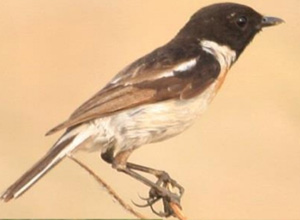
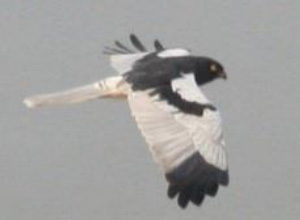
D. Mt Popa: we daytripped this from Bagan (journey a little over one hour). We made a few stops in the dry, scrubby fields en-route, finding Daurian Redstart and White-eyed Buzzard but the actual town and looming rock itself is a bit of birdless, macaque-ridden tourist trap. Some dry forest on the slopes – there is a track running uphill about 500m before the Popa Mountain Resort – was surprisingly birdy given that we reached there at noon. Species included a large and noisy group of Greater Necklaced Laughingthrush, singing White-rumped Shama and Large Scimitar-Babbler.
( 2 ) Getting to and from Mt Victoria The journey from Bagan is 28 km south to Chauka, where a bridge crosses the Ayeyarwady and then 100km west / north west, eventually to the border for Chin State and then uphill to Kanpetlet. With the foot down, this drive can be done in about 5-5½ hours but, as the road passes through some dry deciduous dipterocarp forest that, in many places is still in reasonably good nick it is well worth taking some time and making roadside stops. Thorny and degraded mesquite scrub starts to give way to open forest perhaps 20 km beyond the bridge and from here onwards we made many stops. Key species in this habitat are White-rumped Falcon and Finsch’s Parakeet. Parakeets of at least three other species (Rose-ringed, Red-breasted and Alexandrine), are common, and it took us to nearly the 56km mark (big blue sign on right hand side; don’t confuse with the erratic white mile markers) to finally get good views of perched Finsch’s. Subsequently, and on the return journey, we had good looks at several other pairs. We walked from about 53.5km to 56km, finally finding a perched White-rumped Falcon close to the road right at the 56km sign. This peculiar bird gave terrific scope views. As well as the roadside forest here, other good places to stop included a wooded valley starting right after some obvious steep descending hairpins; again we walked here for several km; other places further along are worth a try as time permits. Notable species seen, many of which did not appear elsewhere on the trip, included Shikra, Crested Serpent Eagle, Lineated Barbet, Asian Barred Owlet, Green-billed Malkoha, Greater Raquet-tailed Drongo, Red-billed Blue-Magpie, Rufous Treepie and nesting Large Cuckooshrike (all seen multiple times) along with singles of Blue-bearded Bee-eater, Oriental Pied Hornbill and groups of Greater Necklaced Laughingthrush, Small Minivet and Hill Myna. Black Baza was something special, seen very well on both legs (nest noted on return journey).
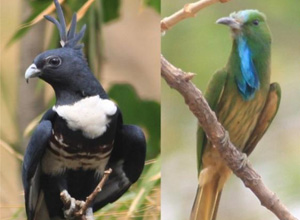
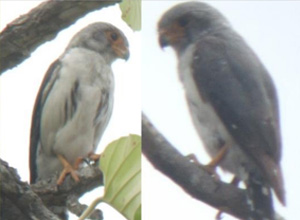
( 3 ) Mt Victoria The crown jewel of Burmese birding, somewhat like a more civilized, less hardcore version of AP’s EagleNest with incomparably improved food and accommodation, and rather better weather (although, of course, not quite the same long list of monster birds). We had three full days here, based at Pine Wood Villas at 1800m, from which it is 19km to the junction where the final 5km track to the summit of Mt Victoria begins. Three days was sufficient to have a very good crack at the place but, inevitably of course, not enough to mop everything up. In particular, we failed to find any parrotbills and Spotted Wren-Babbler (again) eluded me.However, bird quality was outstanding and, for much of the day, each day, bird activity was very good, especially in the higher elevation forests. A full list for this site is given below, so only some brief additional details are given here:
A. Birding is almost invariably from the main track, which is very quiet in terms of traffic and gives plenty of good vistas. A scope was useful to improve views of a lot of things.
B. Whilst tempting to spend more time higher up, some important species were only found lower down, in the scrub around Pine Wood Villas. Here, a track on the right about 20m uphill from the entrance gate and another on the left, less than 100m further lead to some weedy and scrub-choked fields and forest edge that was good for Chin Hills Wren-Babbler, Striped Laughingthrush and, once, a male White-bellied Redstart. The ‘frogmouth track’ is on the right, c1.5km uphill from Pine Wood Villas. Windy evenings and some rain meant we struggled to connect with this one but on the very last morning got one calling back at about 0515. It didn’t show but even in the late afternoon this track was very birdy and would be well-worth devoting some serious time too. Plenty of bluetails and Pygmy Wren-Babbler and, once Crimson-faced Liocichla, were of major interest here. A track on the left a little below the frogmouth track yielded territorial Grey-crowned Warbler.
C. It is worth getting to the top junction very early at least once – we never quite managed this, getting distracted all too readily on the way up and hence had rather poor views, twice, of Mt Victoria Babax.
D. The track to the summit from the junction was very birdy for the first km or so but the one time we ventured further up, we saw rather little save for numerous Fire-tailed Sunbirds and a nice, noisy pair of Whistler’s Warblers in some mossy forest.
E. In April, lots of stuff was clearly on territory and singing strongly, so we
did well for the bush warblers and some
of the laughingthrushes, which were both noisy and responsive. Cuckoos and
flycatchers were clearly arriving
on a daily basis.
Confirmed species list March 29th (late pm) to April 2nd (early am) for Mount
Victoria:

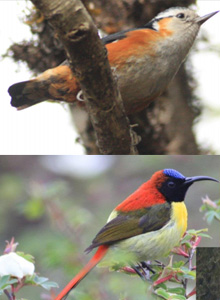
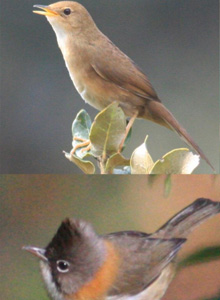
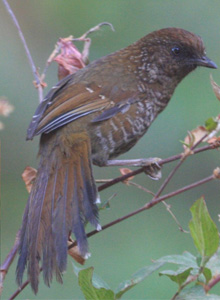
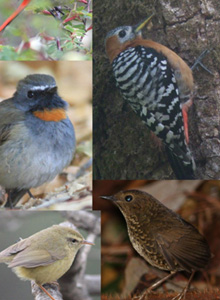
( 4 ) Kalaw area We visited several sites in this area, all fairly close to town. These are indicated on the map on the following page. Sites to the north of town were checked on the first afternoon. The habitat is mixture of rice paddies and intensively farmed crops, with various scrub (site A) and dry hillsides, covered in open pine plantation (site B). The former, visited in the middle of the day, was fairly unproductive but good views of Whitebrowed Laughingthrush, Spectacled Barwing and White-browed Scimitar-Babbler all in the same flock was nice with Burmese Shrike obliging nearby. Fields with a few water buffalo attracted three species of myna but not Collared. Site B, visited late afternoon and just 5-10 min drive from Kalaw centre was rather better. Black-headed Greenfinches were evident all afternoon, giving typical greenfinch buzzy notes from the pine tops. Slender-billed Oriole and the amazing leucotis subspecies of Eurasian Jay were also notable here with Himalayan and Oriental Honey Buzzards also appearing
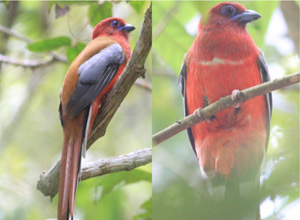
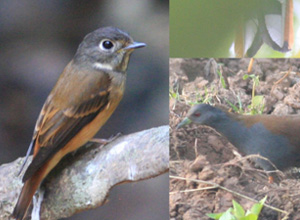
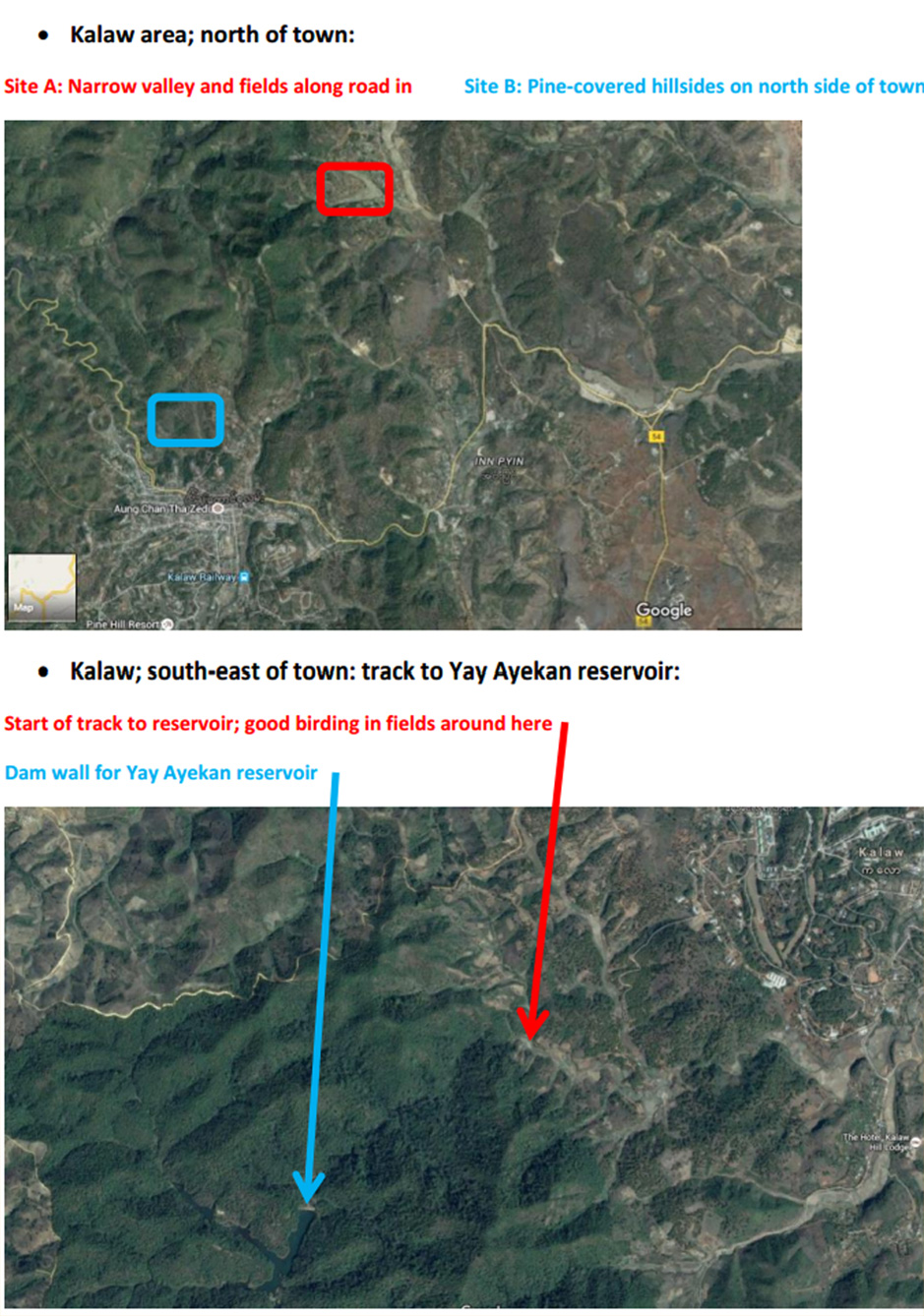
Track to Yay Ayekan: Sites north of Kalaw paled into insignificance compared to Yay Ayekan, a reservoir 15min drive south west of Kalaw on narrow country lanes. Getting there required some inside knowledge, with travelling through a fairly imposing looking army base on the edge of town necessary. However, once there, birding was superb and gave a totally different mix of forest species compared to Mount Victoria. I had most of a day here and then returned for 2 hrs next morning as I was far from done. Bird activity was high until midmorning but strong sun and breezy conditions definitely quenched things significantly from 1000 onwards.
A. Species in the fields before the track included various cuckoos (heard), Grey-headed Woodpecker, Burmese Shrike, Eurasian Jay, Yellow-streaked Warbler, Spectacled Barwing and Black-headed Greenfinch (again calling from areas of dry pines). Best by far was easy looks at Black-tailed Crake, wandering around fully exposed at dawn on both mornings in the tiny stream running out of the forest edge.
B. The short walk to the reservoir was through shady, overgrown forest following a stream bed. A whole host of good species appeared here, but not Burmese Yuhina, despite patient waiting and working through any flocks. Notable species included Red-headed Trogon (superb male seen and heard both mornings about 2/3 of the way along, with Long-tailed Broadbill calling nearby), a totally unexpected Black-backed Dwarf-Kingfisher scoped over the stream on the second morning, Speckled Piculet (right by the dam), Common Green Magpie, plenty of drongos, including the only Lesser Raquet-tailed and Bronzed of the trip, Maroon Oriole, White-tailed Robin (surprisingly easy to see well; clearly on territory), seven species of bulbul, Davison’s Leaf-Warbler singing loudly and commonly, several Marten’s Warblers still on winter territory close to the stream bed and a very responsive Slaty-bellied Tesia singing strongly. Golden Babbler, Yellow-cheeked Tit, Silver-eared Mesia and plenty of Black-throated Sunbirds were very close in busy flocks. There was also some good flycatcher action, comprising six species, including both singles of Ferruginous and Brown-breasted Flycatchers and even a Whitegorgetted on the first 200m of track after the fields.
C. Beyond the reservoir, the immediate forest became rather dryer and open in stature, with only Puff-throated Babbler of note. However, Cook’s Swifts were present mid-afternoon from the dam wall, giving good views and this was also a good place to view soaring Accipters (Crested Goshawk and Shikra).
Driving from Kalaw to Inle, one good area worth stopping at is the flooded fields on either side of the road not far east of Aungpan (20.674686, 96.682584; impossible to miss). This yielded a few herons and other waterbirds, plus Wire-tailed Swallow and Siberian Stonechats.
( 5 ) Inle Lake
We spent our time based at a nice hotel in the village of Nyaungshwe on the north edge of the lake. This is the area’s main tourist area seemingly and boat trips are easy to arrange from here. There is also good birding a short walk or drive along the road west of town (see below).
A. Boat trips: MTE had booked two trips on the lake for us; one the first afternoon and the second, full day trip the next. On the latter we went all the way to Inthein, stopping at various other tourist sites en-route. These were very nice and a good way to get around and see the area, but not especially prolific birdwise. The most interesting areas are the channels and flooded reedbed and lake edge at the north edge, ie very close to Nyaungshwe. The problem is that there appears to be no obvious way from the main north-south channel into this area; all the side channels were low and narrow and trying to approach the bird sanctuary area from the actual lake was also fruitless as, again, water levels were too low. This meant no Chinese Grassbird nor Jerdon’s Bushchat the easy way. There must be some way of getting into the right spots via boat; lots of other people manage it but you clearly need better gen than I had. However, our boatman was as clueless as I. The one special we did see, however, was Collared Myna, seemingly nesting on the temples at Inthein and a good reward for being a tourist for the day. Several pairs were in the area of Shwe Inn Thein Paya, a short walk from the jetty and could be watched for prolonged periods; one pair appeared to be entering a nest hole in an old, falling down stupa. The good news is that there are only 1054 stupas at this site to check… Vinousbreasted Myna were also present, and the rather smart White-vented Myna common in other areas close to the main lake.
B . Other species on the lake included large numbers of Lesser Whistling-Duck with fewer Cotton PygmyGoose, plenty of Garganey and a single Ferruginous Duck. Indian Pond Heron were as common as Chinese Pond Herons here (unlike on the surrounding paddies) and other quality birds included lots of spectacular Pheasanttailed Jacanas, Brownhooded Gulls, Asian Openbills, hundreds of Glossy Ibis and Eastern Marsh Harrier.
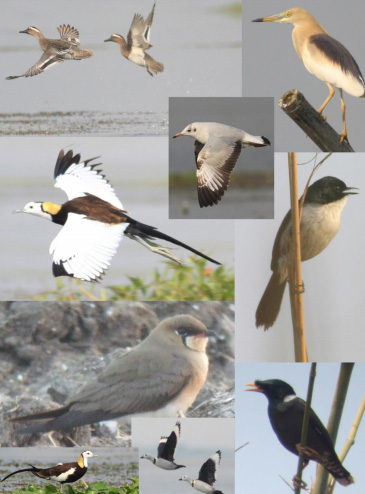
C. Fields west of Nyaungshwe: these were actually much more enjoyable birding than from the boat and I spent two nice late afternoons and one early morning out here. The best spot was around 20.655777, 96.907873, easily reached by walking down the track from the east-west road about 2km east of Nyaungshwe river bridge. Here long, rank grass was easily reachable and Jerdon’s Bushchat seemed very common; I saw at least 12 including a pair behaving as if they had a nest nearby. Other species included Bluethroats, loads of pond herons and other egrets, Ruddy-breasted Crake in the wide drain and a scattering of Oriental Pratincoles in the wetter paddies. Some of the latter positively dripped in wagtails, mainly Citrine (including, after some effort, a superb calcarata) and on the last morning I bumped into a Chestnut-eared Bunting and taped a good candidate for Baikal Bush Warbler, takking and seen fairly well in the long grass. By walking south it may be possible to get into much wetter, lusher habitat here, but I never managed that.
( 6 ) Yangon area: Hlwagu Park
Despite being a fairly green city, there was rather little to see in downtown Yangon. The only exception was plenty of Brown-hooded Gulls on the river and the famous Peregrines on the even more famous Shwedagon Paya.
On the second last day of the trip we flew in from Heho, Inle at noon. We then spent the rest of the afternoon at Hlwagu Park, about a 30min drive from the Yangon’s airport. This was the one part of the trip were our timing was not quite right; this was a surprisingly good site with lots of dry but quite shady forest and quite a few lush ponds and lakes. However, the temperature all afternoon was nearly 40o C. This meant rather slow progress all-in-all with no sign of Davison’s Bulbul and no decent flocks. Even so, I managed six species not seen prior on the trip; these included several Forest Wagtail plus Olive-backed Sunbird and Black-naped Oriole. Most species logged were common and widespread south-east Asian birds but did include Cotton Pygmy-Goose, several Oriental Honey-Buzzard, Puff-throated Babbler and, best of all, a stunning, close Racquet-tailed Treepie near the exit.
